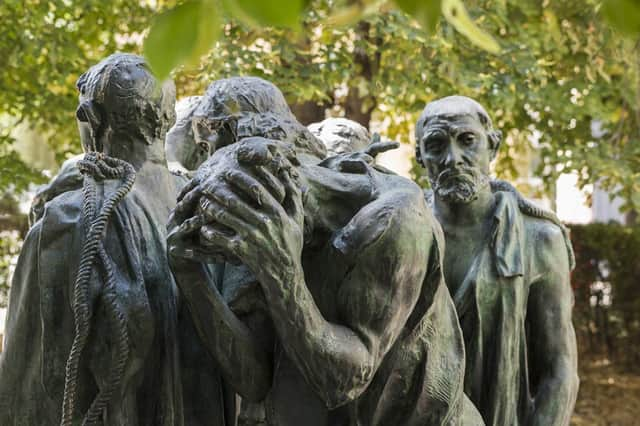Glasgow museums’ £3m Auguste Rodin sculpture is missing
This article contains affiliate links. We may earn a small commission on items purchased through this article, but that does not affect our editorial judgement.


Auguste Rodin is considered the Father of Modern Sculpture in France and exhibitions of the renowned artist’s work continue to attract worldwide attention. Rodin’s The Thinker is one of the most famous sculptures in art history and a cast of the statue, part of The Burrell Collection, is one of Glasgow’s greatest treasures. According to a freedom of information request, another of Rodin’s famous works, purchased by the City of Glasgow, is currently missing.
In Glasgow, there was an early appreciation for Rodin’s work. He was included in the 1888 Glasgow International Exhibition, well before his reputation was firmly established by a seminal exhibition in Paris in 1900.
Advertisement
Hide AdAdvertisement
Hide AdIn 1906, the artist received an honorary doctorate from Glasgow University. He gifted a bust, ‘Saint George’ to Glasgow’s Hunterian Art Gallery in return. Letters between Rodin and Francis Newbury, the visionary founder of the Glasgow School of Art, confirm that the pair were in dialogue around 1901, with Rodin asking Newbury to report on how his sculptures were being received in the Glasgow International exhibition of that year. Glasgow Museums bought two works from that exhibition, a plaster cast of ‘Saint John the Baptist’, and a cast of the ‘Burghers of Calais’.
This second work, known as Les Bourgeois de Calais in France, was damaged after being put on public display after the Second World War. It is listed as “unlocated” by Glasgow Life, the charity that operates the city’s museums and art galleries.
The sculpture, estimated to be worth about £3 million, is missing alongside almost 1,750 other items according to a report from The Sunday Times. City and national collections have been audited in recent months following revelations of thefts from the British Museum that were reported in Auugust.
Jérôme Le Blay, the director of the Paris-based Comité Rodin, which publicises and catalogues Rodin’s work said: “We lose a bit of humanity when we lose a work of art.
Advertisement
Hide AdAdvertisement
Hide Ad“Museums may have 100,000 items, so occasionally things get dropped or get lost in shipping. Art is often destroyed in acts of war — that’s life — but when it goes missing as a result of mishandling or mismanagement by people it is utterly shameful.
“It really is deeply disappointing to discover Glasgow has lost art of this significance and importance.”
Glasgow’s plaster version of Les Bourgeois is one of a number cast by Rodin, with a life-size bronze version standing in the gardens of the Houses of Parliament in London.
Glasgow Life’s “unlocated” list includes an original John Byrne painting of Billy Connolly standing with his banjo, which the painter bequeathed to the city of Glasgow in 1977. Conceived as a diptych, the original banjo half of the painting was lost in transit between exhibitions. Byrne recreated it for Glasgow Museums in 2017.
Advertisement
Hide AdAdvertisement
Hide AdWorks by artists Carlo Maratti, Sebastien Vrancx and Cornelis Vroom are also currently ‘unlocated’, including Vrancx’s 1513 work Landscape with Figures, and Maratti’s The Madonna and Child Surrounded by Angels, thought to date to the 1640s.
A spokesperson for Glasgow Life told GlasgowWorld: “The process of recording, cataloguing and caring for the Glasgow Museums Collection has improved significantly since it was founded in the 1860s. For 30 years, the cataloguing of the collection has been increasingly centralised using the Museum’s Collection Management System. As part of the major museums capital projects in Glasgow over the last 20 years, the storage of the collection has also been improved.
“Glasgow Life Museums has spent more than two decades conducting an inventory of the items in the collection, and, based on these processes, finding objects which had previously been recorded as unlocated. This process has enhanced security of the collections, preventing theft from storage in the last 20 years, and reduced the number of objects recorded as unlocated, even temporarily. Where historic thefts have been conclusively identified, we have robust processes in place including notifying the police and adding the items to the Art Loss register which makes it difficult to secure sales at legitimate auctions.
“The plaster sculpture Les Bourgeois de Calais by Auguste Rodin was exhibited in Kelvingrove Park in 1949. The Sculpture in the Open Air exhibition ran from 25 June to 30 September 1949.
“Les Bourgeois de Calais suffered damage while on display in this exhibition and at present is unlocated.”
Comment Guidelines
National World encourages reader discussion on our stories. User feedback, insights and back-and-forth exchanges add a rich layer of context to reporting. Please review our Community Guidelines before commenting.
